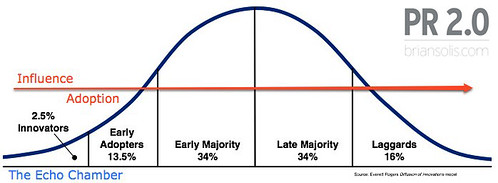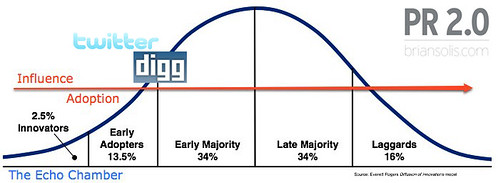We are witnessing either an epic financial meltdown or a long overdue resetting of existing business practices and the hollow markets they create. Or, perhaps we’re experiencing both of these phenomena. Either way, it has the nation gripped with fear, uncertainty, and an unsettling eruption of questionable advice confusing everyone, everywhere.
While the floor is crumbling for many industries much in the same way it did for Silicon Valley during the dotbomb years, the sky isn’t necessarily falling on the startup industry – at least not for those with marketable technology or products, dedicated and capable teams, an executable business plan, and access to the resources necessary to help it reach users and customers.
For those startups that are building and marketing something of value for consumers or businesses, there is much work to do. While there is always a need to attract mainstream users, this isn’t the time to stretch or over-commit resources to hit everyone all at once. Branding is an expensive proposition, one that requires time, capital, diligence, dedicated teams, enthusiastic customers, and patience. As counter intuitive as it may seem, this is exactly the right time to market into the echo chamber to earn the support of influentials who will create significant, concentrated brand visibility and momentum to carry you forward.
Your business can grow with the groundswell and doesn’t necessarily require the instant adoption by the masses in order to succeed in the short term.
Usually, when the economy slides, the first natural reaction is to cut expenses, conserve cash, and hunker-down to weather the storm. All good advice. But don’t forget also that this could be your time to shine, albeit, in a strategic and intelligent way.
Great entrepreneurs build value and market-share in down markets. They go to work seven days a week and the(y) breakout when other folks check out. — Jason Calacanis
Now’s the time to get your head in the game and focus on what it is you do, and go do it better than anyone else. You’re either on the field or you’re on the sidelines.
Any company that intentionally pulls itself from the radar screen of their customers will be absent from customer decisions and referrals. In the process, you create a frictionless opportunity for your competitors to swoop in and fill the void.
There are always customers making decisions, so make sure that you’re part of the equation and process, wherever they go for information and insight.
Influence and adoption historically have migrated from the edge to the center. Or using a more common example, customers and word-of-mouth referrals travel from left to right along a bell curve that starts with Innovators and Early Adopters, peaks with the Early Majority and the Late Majority, and finally permeates with reaction from Laggards.

If you dissect the art and science of technology marketing using a car as a simple metaphor, your product serves as the chassis, your cash as the fuel, Social Media, Interactive/Web, Sales, SEO, and PR as the accelerator, marketing strategy and execution as the gears, RPMs as a market indicator for listening and responding, the speedometer to convey inertia, and you, as founding executive, sitting in the driver’s seat, steering and controlling the entire operation.
Marketing to the echo chamber, believe it or not, is how you get that car rolling, starting everything in first gear. Appealing to those who can help spark word of mouth is how you can accelerate, gain enough speed to shift into second, and subsequent higher gears, and attract new users and evangelists along the way, growing in distance and reach at every turn. It is the echo chamber that can help you efficiently gain velocity in order to progressively reach greater audiences and command additional financing and also revenue in the process. With its support and assistance, it is almost like starting with a colossal push.
You have to start by engaging those who’ll get it, and in turn, share it with their peers. It’s an ongoing process that strengthens with each cycle.
Hopefully you are building your business in a way that is independent of the stock market.
— Kevin Ryan
The world doesn’t flock to new things en masse. It takes a focused and progressive strategy that evolves and matures over time. In a down economy, this is non-negotiable.
Digg and Twitter are among some of the best examples of how alpha users can help promote a company or service by embracing these new solutions and religiously demonstrating why they are pervasive and useful. And, emphatic users also contribute to the community building process, assisting in the translation of the value proposition for different markets as well as enticing and compelling their peers to join them, which offsets and relieves the company from carrying the bulk of the responsibility for promotion and guerilla marketing.

But, where are Digg and Twitter in respect to the adoption cycle? They’re not as far along as you think judging by the buzz and permeation of your social graph. These companies still have oceans to swim until they become household brands. But, that’s OK. They’re building a business, cultivating legions of dedicated user communities, evolving and improving their product, and still conserving cash. Remember, it took brands such as eBay, Youtube, Google, and Amazon hundreds of millions of dollars and armies of enthusiasts and partners to achieve saturation – and many would argue that there’s still much work to be done.
I would bet on any company that earned the support of innovators and early adopters and took the time to listen to feedback in order to iterate based on real world needs, preferences, pains, and new ideas.
Without influence, you’re going to spend precious resources, more than you can afford, convincing people that they should pay attention. Peer-to-peer marketing is priceless and still your best bet for having a shot, and more importantly, making a long-term impact.
But you first need a spark, something to start that avalanche that grows as it races downhill.
The echo chamber is bigger than we think or give it credit for. In fact, think of the echo chamber as its own bell curve. Most of the blogs and users that naturally come to mind, may reside on the left side, leaving a wide array of technology enthusiasts to uncover and pursue.
Innovators and early adopters are global citizens and do not solely reside in Silicon Valley. Figure out who your market is today, tomorrow, next month, and set goals for user acquisition so that you can tweak your product and tailor your messages to those very people, as they’ll uniquely connect to your story, and also share it differently among their peers, as it traverses across the bell curve.
Remember, reporters, bloggers and online tastemakers (aka trendsetters) who spotlight innovation can send tens of thousands of new and loyal users to you almost instantly. I’m not just referring to unique visits of those who sign up, test things out, and then leave to try the next shiny service. When done right, the echo chamber can generate real world interest and support. It is these very users who tell you everything about what works, what doesn’t, and how to improve. These same individuals and networks also augment and complement your marketing efforts by legitimizing you’re products, associating credibility and providing pseudo endorsements, and in turn, giving you unprecedented access to their invaluable and highly connected networks of early adopter friends.
This is the time to focus on user acquisition. This is edgework. Everything starts with an intimate understanding of the markets you’re trying to reach and an even deeper connection to the peers, voices, and other channels that influence them. Most of you are not marketing iPhones, gaming consoles, premium spirits, or new music artists. At the very least, you are redefining how people communicate, collaborate, connect, and ultimately work.
There’s a prevailing necessity to educate your markets and introduce not just new products and services, but also change the daily routines of everyday people.
Therefore the goal to race from zero to 60 and hit mass penetration immediately is not necessarily the primary goal. If we look at business development and communications as a series of strategic stages, we realize that there are focused activities that we must pursue and smaller, reachable voices we must reach and convince to help us carry and adapt our story from stage to stage – each time, addressing the needs and pain points of the individual, respective groups.
Of course, as you learn, internalize feedback, change, adapt, and engage with your markets, the foundation for your business solidifies and begins to afford and beget expansion. It is at this point in time, when you can continue to expand your focus and reach to attract and inspire users residing outside of the echo chamber.
Nothing beats a killer product idea and an impressive, objective, and focused team to carry it forward. Expectations count and will determine how you channel information and progress. Think too big and you’ll miss your target and burn through resources before you can ever earn any significant market traction. Aim too low and the market will pass you by.
In this volatile economic climate, the echo chamber can be your direct connection to success, or at the very least, help to kickstart market adoption of your products. It is a global incubator designed to help you grow, gain momentum, and ultimately propel your business across the bell curve to appeal to and attract a wider, active base of customers.
We live in interesting times and it’s up to us, and only us, to define our future.
(Photo by Wetwebworks).
